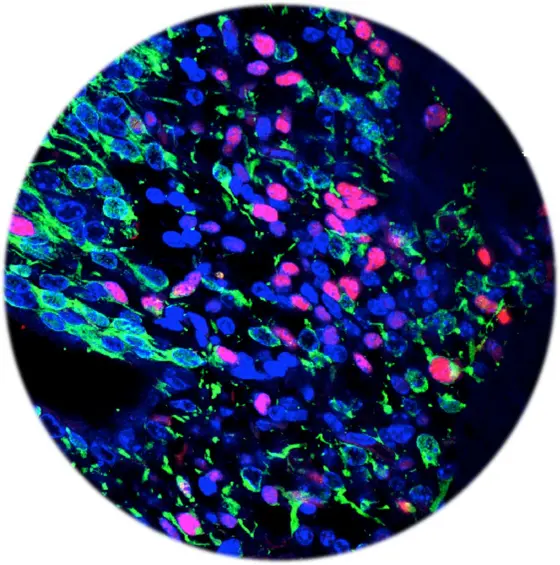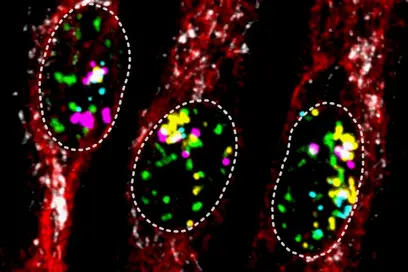Cancer researchers believe that many types of cancer originate from stem cells that have undergone transformations. This theory has far-reaching implications for cancer therapies, which may only be effective over the long term if they eliminate the cells from which the disease originates. However, in many types of tumors, scientists have yet to identify markers that are typical of such stem cells. “In order to specifically attack cancer stem cells, we first need to know the exact molecular structure that the therapy targets,“ says Dr. Haikun Liu from the DKFZ. “However, until now there has been no convincing evidence to suggest that cancer growth can be slowed down by turning off tumor stem cells.“
Now for the first time, the DKFZ stem cell experts have been able to provide such evidence. Experiments with mice led to the identification of a protein called Tlx, which plays a key role in brain cancer stem cells. When the scientists switched off Tlx, cancer stem cells lost their ability to renew themselves, and animals with tumors survived longer.
Tlx is a so-called “nuclear receptor“ that controls many genes involved in tumorigenesis. In previous studies, Liu had found that Tlx is important to the functions of normal neural stem cells. Higher-than-normal levels of Tlx promote the development of these neural stem cells into malignant brain tumors.
The brain tumors that Liu and his team studied in mice had properties resembling those of aggressive glioblastomas in humans. The researchers engineered the mice genetically that the tumor cells become green when Tlx gene is activated. Such cells constituted only a small portion of the total population of tumor cells. They divided slowly and, in cell cultures, grew into spherical structures called spheroids, which are considered a typical characteristic of stem cells. The fluorescent marker revealed that Tlx-positive cells can renew themselves and also generate “Tlx-negative" offspring. This means that the offspring have undergone a process of development, which is one of the defining features of stem cells.
Most interestingly, Dr. Liu and his team further engineered the model that allows them to switch off Tlx in fully established mouse glioblastomas, which is closely mimicking tumor therapy in clinic. Experiments in mice in which the scientists switched off the production of Tlx in the tumor stem cells promoted a longer survival of the animals. “Blocking Tlx reprograms the tumor stem cells toward a more non-malignant fate,“ Dr. Liu explains.
A look into the scientific literature suggested that the results were relevant beyond mice. In genome data collections of the U.S. TCGA Consortium, the scientists discovered that a high level of activity of the Tlx gene is associated with a particularly unfavorable prognosis.
Using cultured cells, Liu's team then turned off Tlx in various human glioblastoma stem cell lines. The cells lost their ability to form spheroids and could no longer be transferred from animal to animal in a continuous series. These are two classic methods to establish the properties of “stemness" in cells, which had now been lost in the glioblastomas.
“We have shown that the growth and survival of brain tumors are dependent on the tumor stem cells," Dr. Liu summarizes. “We have identified Tlx as a target structure to be hit in these stem cells. We also now know that human glioblastoma cells depend on Tlx to maintain the properties of stem cells. Since blocking Tlx prolongs survival in mice, we assume that this may also be an effective strategy in slowing down the growth of aggressive brain cancer in humans."
Tlx has further characteristics that make the scientist believe it will be a promising target for novel therapeutic approaches: The protein occurs only in cells of the central nervous system, where its inhibition is unlikely to lead to any severe side effects. Additionally, studies of other nuclear receptors have revealed that they make good targets for inhibition by therapeutic substances.
Zhe Zhu, Muhammad Amir Khan, Markus Weiler, Jonas Blaes, Leonie Jestaedt, Madeleine Geibert, Peng Zou, Jan Gronych, Olga Bernhardt, Andrey Korshunov, Verena Bugner, Peter Lichter, Bernhard Radlwimmer, Sabine Heiland, Martin Bendszus, Wolfgang Wick, Hai-Kun Liu: Targeting Self-renewal in High-Grade Brain Tumors Leads to Loss of Brain Tumor Stem Cells and Prolonged Survival. Cell Stem Cell, 2014, DOI: 10.1016/j.stem.2014.04.007



